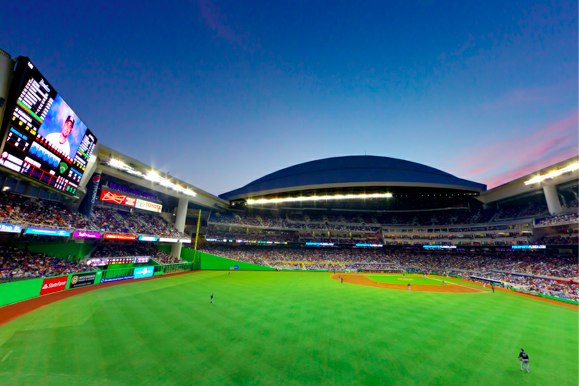
We’ve seen a raft of articles declaring Marlins Park a failure, but we’re not so sure; the new Miami ballpark has led to a 49 percent increase in per-game attendance from old ballpark to new — the third-best this century.
It’s easy to blast the Miami Marlins front office for ineptitude, especially after the trading of popular and productive players at the trade deadline. It’s the way MLB teams do business: teams that clearly aren’t going to contend retool for next season and use the occasion to stock up the farm system. Target Field isn’t a failure because Terry Ryan trades Francisco Liriano. Now, it’s true that Jeff Loria and David Samson are not among the most popular people in the media, and their stewardship of the Marlins — and the Montreal Expos before that — has been controversial, to say the least.
But there’s one metric missed by the likes of sloppy Forbes bloggers: per-game attendance rises. Indeed, if you look at teams increasing attendance on a daily basis after the opening of a new ballpark– certainly a useful metric, maybe even more useful than total yearly attendance — then the opening of Marlins Park has been one of the more successful in MLB since 2000, and certainly not close to the worst.
Here is a list of teams opening new ballparks this century, along with the per-game attendance during the ballpark’s first year open. We’ve also included attendance figures for the year prior and calculated how much attendance went up or down:
| TEAM | NEW PARK | OLD PARK | +/- | YEAR |
| Brewers | 34,704 | 19,427 | 79% | 2001 |
| Giants | 40,973 | 25,659 | 60% | 2000 |
| Marlins | 28,405 | 19,007 | 49% | 2012 |
| Padres | 37,243 | 25,024 | 49% | 2004 |
| Pirates | 30,839 | 21,591 | 43% | 2001 |
| Phillies | 40,626 | 28,973 | 40% | 2004 |
| Twins | 39,798 | 29,466 | 35% | 2010 |
| Reds | 29,077 | 23,199 | 25% | 2003 |
| Tigers | 30,106 | 25,018 | 20% | 2000 |
| Nationals | 29,005 | 24,217 | 20% | 2008 |
| Astros | 37,730 | 33,000 | 14% | 2000 |
| Cardinals | 42,588 | 43,691 | -3% | 2006 |
| Yankees | 45,364 | 53,069 | -15% | 2009 |
| Mets | 38,941 | 51,165 | -24% | 2009 |
Sources: ESPN, baseball-reference.com
We’re not inclined to consider the new Yankee Stadium or Citi Field failures, despite the big drops in average attendance: building smaller ballparks was part of the business model for both teams. The fact that the Cardinals suffered a slight decline at the new Busch Stadium can also be partly attributed to a smaller ballpark and a slightly different business model.
But look at all the other teams on the list: many were in the same boat as the Marlins in moving from a fairly wretched or limited ballpark (Three Rivers Stadium, County Stadium, Qualcomm Stadium, Veterans Stadium, Metrodome, RFK Stadium, Astrodome) to a sparkling-new facility. And the daily attendance for the Fish certainly mirrors the numbers put up by the Reds and Nats in their first seasons in new ballparks.
At the end of the day, there’s really only one metric that matters: how much the move affected the Marlins’ bottom line. Sure, we’re guessing everyone was hoping for an even bigger attendance boost for the Fish. And it’s a valid argument that the team underperforms in what should be an excellent baseball market; we’d agree. But it’s hardly true Marlins Park is the biggest new-ballpark bust this century. Since the Marlins received only a portion of Sun Life Stadium revenues and now receive most of the revenues from Marlins Park, there’s no way the move could be anything but a boost to the bottom line — as is the 49 percent increase in average attendance.
—-
Share your news with the baseball community. Send it to us at editors@augustpublications.com.
Are you a subscriber to the weekly Ballpark Digest newsletter? You can sign up for a free subscription at the Newsletter Signup Page.
Join Ballpark Digest on Facebook and on Twitter!
Follow Ballpark Digest on Google + and add us to your circles!
